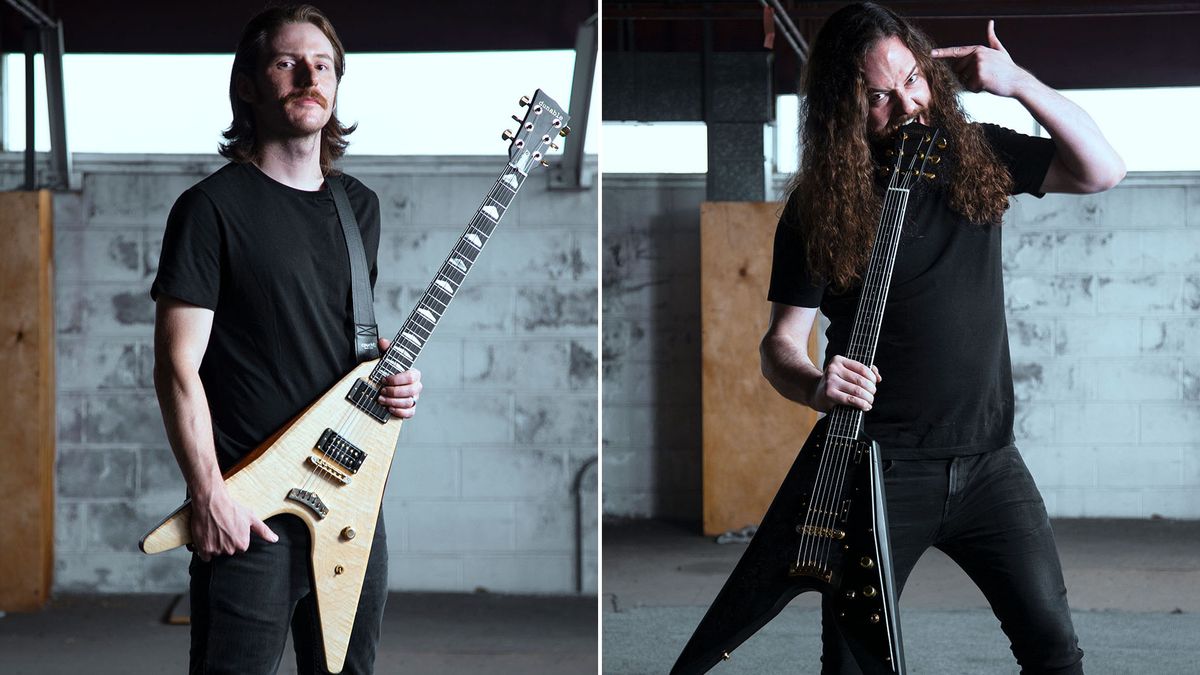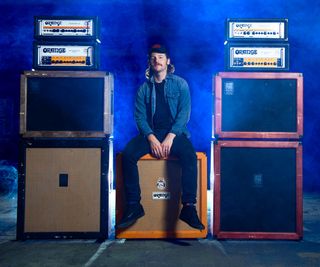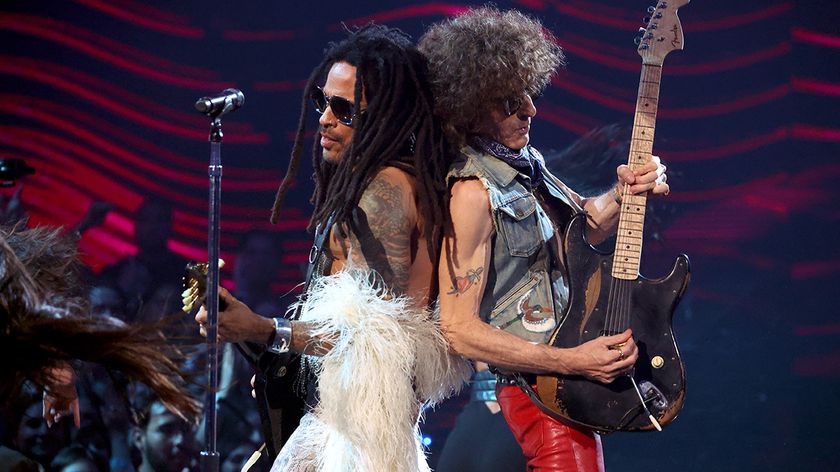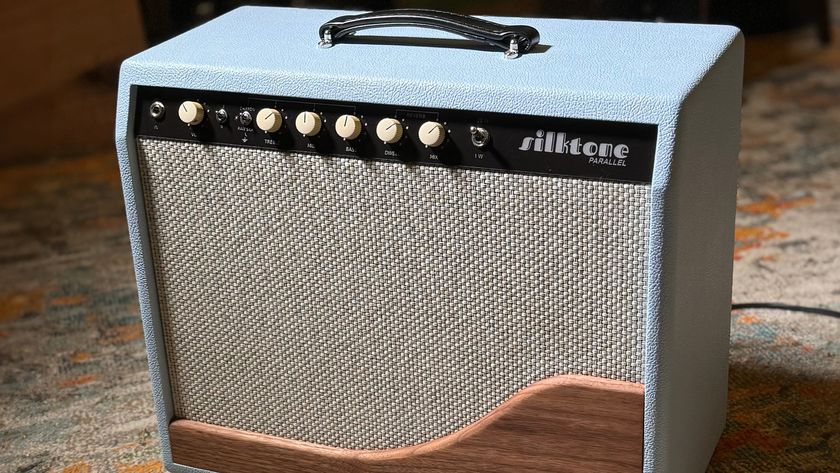Khemmis: “If our riffs sound like Iron Maiden trapped in a tar pit, then we’ve done them right!”
Phil Pendergast and Ben Hutcherson of the Denver Doom metallers talk honing their tone, covering Alice in Chains and a moment of pedal “divine inspiration” that occurred while recording new LP, Deceiver

On their fourth studio album – titled Deceiver and set for release this month – Denver doom metallers Khemmis are dialing in some of the most crushing guitar sounds of their career to date.
For Phil Pendergast and Ben Hutcherson, who both play guitar and sing, the main tones came from pairing their custom Flying V-style Dunable guitars with the Orange amps they’ve been using since 2018…
“Our Dunables into the Rockerverbs are the base of the tone,” explains Ben. “We both play Dunable Asteroids made by Sacha Dunable in Los Angeles. He’s the guitarist/vocalist in Intronaut who started that company around six years ago. He’s built us each a few custom guitars that are absolutely stellar.”
As it turns out, the idea of investing in custom-made instruments was not something Ben originally had in mind, though once his first one arrived he quickly realized it wouldn’t be the last...
“I’d never had a custom guitar before because I always felt I was a bit fickle when it comes to gear. What I like today I won’t like tomorrow! [laughs] Spending all that money and committing to buying one felt a bit scary. But I gotta tell you, the moment it arrived I realized why people go to the custom shop. It all made sense to me. The guitar was exactly what I wanted.
“My main one has a mahogany body with a burl maple top and ebony fretboard, with Bare Knuckle pickups. I started working with them last year and put a Black Dog in the bridge. It turns out a Black Dog in a mahogany-bodied guitar is the sound I’ve been hearing in my head for 15 years… I just didn’t know it! So I’ve got that in the bridge and a Cold Sweat in the neck.”
“I started in this band with a Reverend Volcano,” adds Phil. “It was the V that started me off. Ben had a Gibson one. Both were sick guitars but over time we wanted something with a longer scale length. Even that extra inch or so you get with Fender necks helps a lot with maintaining string tension when tuned down like we are.
Get The Pick Newsletter
All the latest guitar news, interviews, lessons, reviews, deals and more, direct to your inbox!
“We’d played with Intronaut before, so our buddy Sacha built us some with the longer scale length. I really wanted one that looked like Mick Ronson’s Les Paul from the Ziggy Stardust Band, so I got a natural finish maple top on mahogany. I drew him a picture of what I wanted and it looks exactly the same. You don’t get that with an off-the-shelf Gibson.”
So are both of you now using Bare Knuckle pickups?
Hutcherson: “Yeah! Phil uses the Riff Raff in the bridge, which is a little spankier with more of a high-mid focus compared to my low-mid focus. I love how the Oranges sit in between distortion and fuzz, with this natural midrange that sits in the mix exactly like guitars should.
“Over the years, I’ve experimented with a lot of different boosts and for this album I settled on an EarthQuaker Plumes. There’s something about the mode three of that pedal that tightens up the Rockerverb but doesn’t change the tonal character too much… it just emphasizes what I want more of. The nice thing about the Rockerverbs is that they are surprisingly versatile.”
When we got our Dunable guitars, we’d ordered the perfect inverse of color schemes with no discussion between the two of us
It’s a common misconception that Orange amps only suit darker blues and classic/stoner rock…
Hutcherson: “I know! People tend to make the mistake of thinking Orange are just for that or stoner fuzz tones. But, I mean, Jim Root from Slipknot uses them. You can do a lot with those amps depending on what you boost them with and what kind of cab you run into.
“As for the cabs, we used the same one we’ve used on everything – this magical Orange 4x12 that I’ve had for 12 years which has V30 and WGS ET65 speakers in an X-pattern. There’s something about that combination of those specific speakers, and the fact they’re really broken in, that sounds awesome. That’s the primary rhythm tone.”
Pendergast: “I was using the Xotic EP Booster, which is dead simple with a single knob and based on the Echoplex preamp. We found the sweet spot on the knob where it was boosting the amp enough to add some gain and push without muddying things up.”
It’s widely regarded as one of the best ‘always-on’ pedals out there…
Pendergast: “And rightly so. That’s how I was using it, even on the clean channel it sounds awesome in between the Dunable and Orange. Funnily enough, we both had put an order in with Sacha but kept it a secret. When we got the guitars, we’d ordered the perfect inverse of color schemes with no discussion between the two of us.
“There are some pictures of us floating around on the Internet… whoops, that quote could be taken out of context. [laughs] We save most of that stuff for our OnlyFans! Seriously though, that seemed to speak about the transcendental creative connection me and Phil share. People sometimes say they are so in love they finish each other’s sentences. Well, me and Phil finish each other’s riffs!”

Your take on doom is more of a metallic one – closer to bands like The Sword than the murky stoner fuzz of Electric Wizard…
Pendergast: “We all listen to a lot of metal, but none of us actually listen to much doom. [laughs] We’re more influenced by classic heavy metal and rock and roll like Judas Priest, Iron Maiden and Metallica, as well as a bit of death metal and black metal.”
And, unlike a lot of other doom bands, there are some moments of shred in the mix, too.
Hutcherson: “I don’t really think about guitar heroes much anymore, per se. So it’s always interesting to wonder how I ended up here. I think a lot of the shred stuff came from Muhammed [Suiçmez] from Necrophagist and his sense of composition, with use of neoclassical shred in a way that doesn’t sound masturbatory. It was more like an extension of what he was already doing…
“People might be surprised to hear we’re that inspired by a tech-death band but good songwriting and guitar playing transcends genre boundaries. Trey Azagthoth [Morbid Angel] was another big one, because of his sense of phrasing and the way he incorporates symmetrical chromatic runs across the fretboard that are ‘wrong’ but tell a story that playing in scales does not do.
“And then there’s Billy Gibbons! You might not associate him with shred, but he knows the importance of finding the right note over 1,000 okay notes, which is something I’ve always tried to do.”
I’ve been practicing a lot over quarantine, sat there with the metronome and working on hand coordination, string-skipping and pick slanting. All things I should have started doing earlier but hey, 36 is the new 20!
It’s the art of telling a story, right? And Mr. Gibbons certainly has enough stories to tell…
Hutcherson: “Exactly. Guitar solos should help build the story of the song rather than be someone’s turn in the spotlight. I discovered metal in the anti-guitar solo age of the late '90s, so I’ve always preferred the idea of a solo being central to a song rather than the song being written as a platform for a solo. Anybody can learn to play fast…
“I’m not saying it’s not hard. I’ve been practicing a lot over quarantine, sat there with the metronome and working on hand coordination, string-skipping and pick slanting. All things I should have started doing earlier but hey, 36 is the new 20! Good lead work contributes to the song, that’s always the focus.”
There’s also an art to the tempo of your riffs – they just wouldn’t sound the same without that slow mid-tempo drag…
Pendergast: “Our riffs are based on feel and you can just tell when it’s working right. We try to play into the song dynamic – you might be at a certain point in the song and it will demand something a bit more open.
“So we’ll come up with a slower riff, while at other points in a song might demand something more up-tempo and aggressive, like the opening of the first track on the record or the verse riff on the final song where we are going for something a little more driving.
“Those riffs get up to about 160bpm, so we do occasionally go there but that’s the exception rather than the rule. It gives us more dynamics to play with. The feel has to be right and if that means our default is somewhere in the middle – it gives us a place where we can slow down or accelerate.”
Is it a conscious thing or do you find your riffs just come out like that naturally?
Hutcherson: “It’s usually something we don’t think about. We pick up our guitars and start writing for this band and it comes out in that 90 to 110 bpm range. That intuitively feels like the right move. We’ve certainly had moments where we’ve noticed things might push too fast or drag, but those are the exceptions – it’s one out of every 15 riffs where we need to tweak the tempo. If it feels like Iron Maiden trapped in a tar pit, then we’ve done it right!”
Pendergast: “It’s all about the feeling, so we might not use typical downstrokes – putting upstrokes in there to carry the music forward in an interesting way. It’s not deliberate; it’s just our natural feel.”
Hutcherson: “It comes from that classic rock side of us, too. All the big rock songs from the '60s and '70s tended to be pretty slow compared to modern music. It allowed for some interesting rhythmic things to happen across the board, but especially for guitar.
Three years ago if you asked me what a dotted note was, I wouldn’t have been able to tell you. I didn’t think about theory in that way
“One thing I’ve recently discovered about our music is how often we play dotted notes. We do a lot of stuff on the and, from low rhythm riffs to harmony lines. Three years ago if you asked me what a dotted note was, I wouldn’t have been able to tell you. I didn’t think about theory in that way. Now I’m able to dissect it and trace it back to ZZ Top and Thin Lizzy, because those bands are so ingrained in our DNA.”
What other pedals were you using on the new record?
Hutcherson: “There is a delay pedal, the The Ambience, made by a little boutique company in the Pacific Northwest called Mr. Black that is my favorite pedal that I’ve ever played, regardless of classification. It’s also the only delay pedal that our producer Dave Otero has let us put on a record because he’s always into doing delay in post so it can be tempo synched. Going as far back as [2016 second album] Hunted, I told him I wanted to use that pedal for a certain part and he was like, ‘Whoa, this thing sounds too good to not use!’
“So that ended up on this record, both in the typical effects loop way and in front to create this cascading wall of swirling noise for long melodic lead lines. Phil actually got inspired in the moment and jumped on the floor while I was tracking to change all the parameters as I played.
“What he did in that moment of divine inspiration was the take we used on the album. It only worked with that pedal. I can’t find a setting on it that doesn’t sound phenomenal.”
Pendergast: “We also used the Shepard’s End flanger, which is another Mr. Black pedal. It’s on Ben’s lead part at the end of the last song. It sounds subtle but adds this psychedelic edge.”
You covered Down in a Hole for an Alice In Chains tribute album [Dirt (Redux)] that came out last year. By changing some of the chord movements and overall sonic presentation you really made it your own...
Hutcherson: “I think playing a cover straight is a waste of time because the original already exists. If you want to do karaoke, go to the pub and do it there. Of course, the original version is amazing. That album is one of my top five albums of all time. So for us to set aside the time to learn it before disassembling it and then recording it, we had to do it justice. We wanted to pay tribute to the song, which every cover should, but also do things that the original artist didn’t think of.
“If someone covered a Khemmis song, I’d want them to take it into the stratosphere and do something insane. We chose to be reverent – not make it into an unrecognizable thing but also get into a different headspace, minus the heroin, and get that feeling across. That sense of hopelessness through the colors we paint with, doing the song justice, rather than buying the exact same G&L that Jerry [Cantrell] used to copy it perfectly.”
Pendergast: “We wanted the cover to sound like us. It was supposed to be an illustration of who we are… almost as if it was a song that we had written ourselves. That meant throwing in a funeral doom section after the first chorus, because we felt the song could go there, and bring some black metal into the bridge section before the last chorus. That’s what we would have done if it was our song. You’re handed this great set of lyrics and chord progressions, so take it and interpret it as you will!”
- Khemmis's new album, Deceiver, is out November 19 via Nuclear Blast.
Amit has been writing for titles like Total Guitar, MusicRadar and Guitar World for over a decade and counts Richie Kotzen, Guthrie Govan and Jeff Beck among his primary influences as a guitar player. He's worked for magazines like Kerrang!, Metal Hammer, Classic Rock, Prog, Record Collector, Planet Rock, Rhythm and Bass Player, as well as newspapers like Metro and The Independent, interviewing everyone from Ozzy Osbourne and Lemmy to Slash and Jimmy Page, and once even traded solos with a member of Slayer on a track released internationally. As a session guitarist, he's played alongside members of Judas Priest and Uriah Heep in London ensemble Metalworks, as well as handled lead guitars for legends like Glen Matlock (Sex Pistols, The Faces) and Stu Hamm (Steve Vai, Joe Satriani, G3).

“We had 15 minutes left, and it was time to go… I just started playing that riff. Then Lenny goes, ‘Whoa, what’s that?’” Lenny Kravitz guitarist Craig Ross reveals the serendipitous roots of a Kravitz classic

“The concept of the guitar duel at the end was just appalling”: Crossroads is an essential piece of '80s guitar lore, but not every guitar legend was a fan of the film









